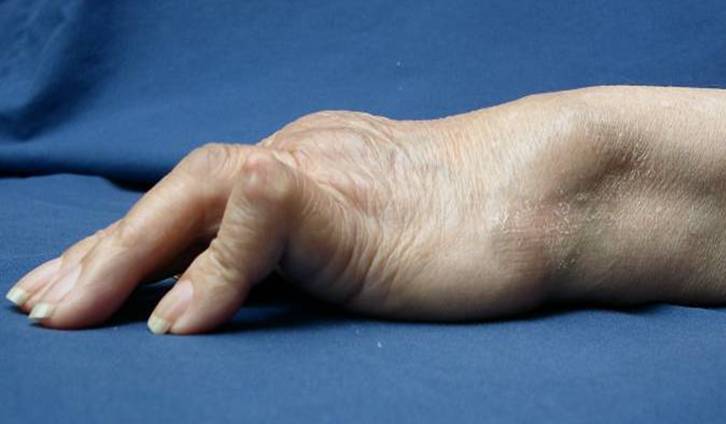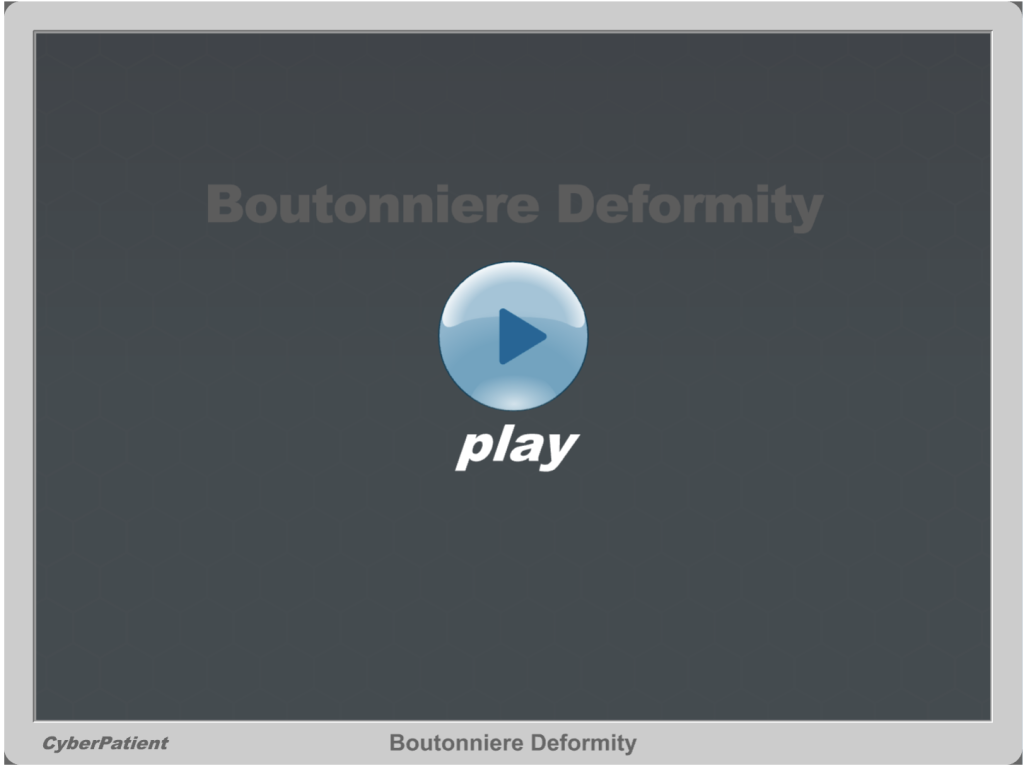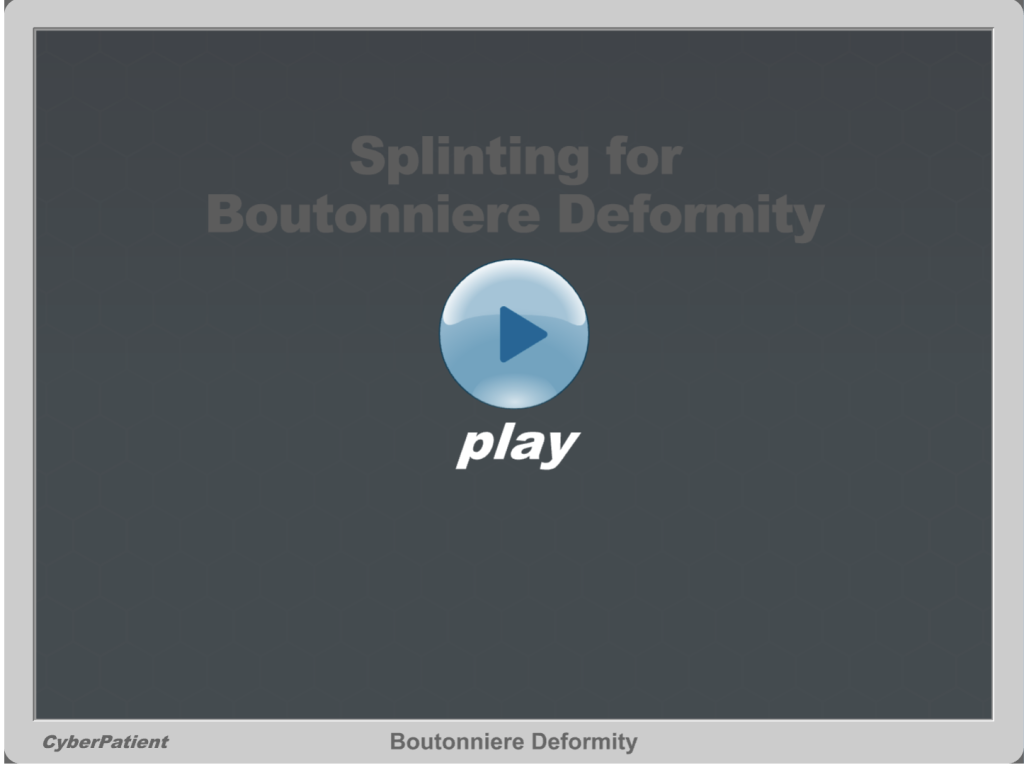Description #
Boutonniere Deformity (BD) is a common hand deformity in patients with rheumatoid arthritis. BD can develop early in the disease process and have significant impact on hand function and quality of life. It is crucial that health care professionals have a good understanding of the pathomechanics in order to properly assess and manage this hand deformity. This unit will cover:
- Pathomechanics of BD
- Components of a RA hand assessment – key tests
- Hand Exercises for BD
- Splinting for BD
Learning Objectives #
On completion of this unit, you will be able to:
- Describe the pathomechanics of Boutonniere Deformity (BD) in rheumatoid arthritis (RA).
- Understand components of a RA hand assessment and be confident in performing key tests.
- Prescribe appropriate hand exercises for BD.
- Understand the role of splinting for BD.
- Understand joint protection principles for BD.
Introduction #
Rheumatoid arthritis (RA) is a chronic, systemic, autoimmune disease characterized by symmetrical peripheral polyarthritis1. RA has the propensity to target the wrist and hands causing joint destruction and weakening of the periarticular structures leading to irreversible hand deformities2. 59% of individuals develop one or more hand deformities after 10 years of disease duration3. The presence of hand deformities is a predictor of disease severity and is correlated with a positive rheumatoid factor, active synovitis and disease duration3,4,5. Hand deformities, together with pain and decreased muscle force, can have significant functional consequences and impact quality of life6.
This module will introduce you to one of the common hand deformities in RA: Boutonniere deformity (BD). It is recommended that you first read/view the materials in the “Recommended Reading/Viewing” section (see Content Navigation) before beginning this module.

References:
- Carmona L, Cross M, Williams B, et al. Rheumatoid arthritis. J Best Pract Res Clin Rheumatol 2010:24:733-45.
- Cima SR, Barone A, Porto JM, et al. Strengthening exercises to improve hand strength and functionality in rheumatoid arthritis with hand deformities: a randomized controlled trial. Rheumatol Int.doi:10.1007/s00296-012-2447-8.
- Johnsson PM, Eberhardt K. Hand deformities are important signs of disease severity in patients with early rheumatoid arthritis. Rheumatology 2009;48:1398-1401.
- Madenci E, Gursoy S. Hand deformity in rheumatoid arthritis and its impact on the quality of life. Pain Clinic 2003;15:255-259.
- Eberhardt P, Malcus Johnson P, rydgren L. The occurence and significance of hand deformities in early rheumatoid arthritis. rheumatology 1991;30:211-213.
- Porter BJ, Brittain A. Splinting and hand exercises for three common hand deformities in rheumatoid arthritis: a clinical perspective. Curr Opin rheumatol 2012;24(2):215-221.
Boutonniere Deformity in Rheumatoid Arthritis #
Welcome to Boutonniere Deformity (BD) in Rheumatoid Arthritis (RA) video lecture. This video will introduce you to:
- The basic pathomechanics of BD
- Components of an RA hand assessment with focus on key tests
- Hand exercises for flexible BD
- Splinting for BD

Click on the link below to view the lecture.
Click on the link below to view the lecture.
Animation: Pathomechanics of BD* #

Video Demonstration of Key Tests #
This video will review three tests that are commonly used for boutonniere deformity. They are:
- The elson’s test
- The central slip tenodesis test
- The oblique retinacular ligament test
The first two tests are used to assess the integrity of the cetnral slip because disruption of this structure plays a role in the development of a boutonniere deformity. The third test is used to asess the oblique retinacular ligament which, if tight, can further accentuate DIPJ hyperextension in a boutonniere deformity.
Although many of these tests lack research into their psychometric properties, these maneuvers, when performed properly by skilled clinicians and used in combination rather than in isolation, can be powerful clinical tools.
References:
- Elson RA. Rupture of the Central Slip of the Extensor Hood of the Finger – A Test for EarlyDiagnosis. J Bone Jiont Surg 1986;68B:2:229-231.
- Mackin EJ, Callahan AD, Skirven TM, et al., editors. Rehabilitation of the hand and upper extremeity. 5th ed. St Louis:Mosby Inc.;2002. pp.125-133.
- Smith PJ, Ross DA. The Central Slip Tenodesis Test for the Early Diagnosis of Potential Boutonniere Deformities. J Hand Surg (Br) 1994;19(1):88-90.
- Yang H, Zhou C. Ultrasonographic diagnosis of central slip rupture in the finger extensor mechanism of the PIPJ. J First Mil Med Univ 2005;25(5):556-557.
Animation: Splinting for BD* #

